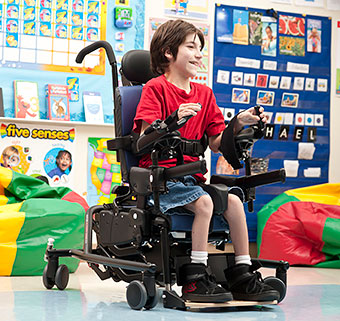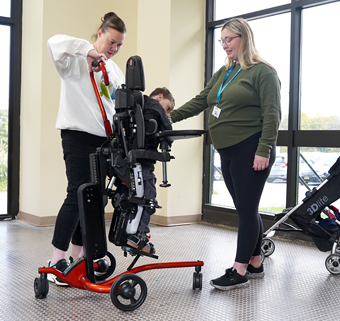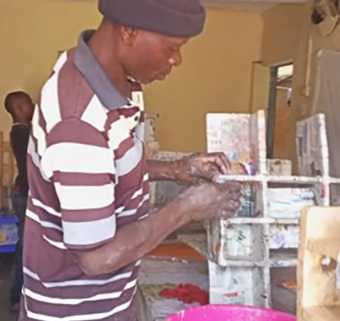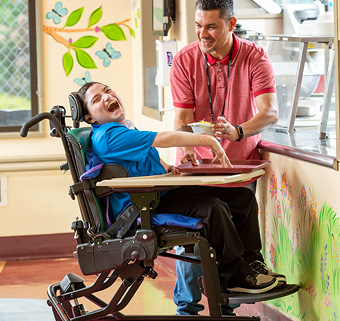Talking About Posture Care & Disability
| March 2016 Using 24-Hour Postural Care to Combat the Twin Foes of Gravity and Time
Using 24-Hour Postural Care to Combat the Twin Foes of Gravity and Time
The word “posture” often conjures memories of being told to “sit up straight” as a kid – but that is not what we are talking about here. Postures that are used persistently as a habit will have a huge impact on the lives of people with motor disabilities – and not for the best! While most of us take for granted our choice of the postures we assume, this is not the case for people with impaired movement. When we have the intrinsic ability to control our bodies against gravity we can choose to move, assume and maintain all kinds of positions. We may choose whether to slouch as we relax or sit erect as we work, but what if we did not have that choice?
Limited ability to move is a game changer when gravity takes over. This is true not only for those who can move little or not at all, but also for individuals who move in limited ways because of muscle tone irregularities, sensory impairment, poor coordination, joint contractures and other factors. We can describe this as having a limited movement repertoire. When one cannot easily and frequently move into a variety of different postures during the day and night, gravity and time become the foe.
The Unbalanced Body
Basic laws of physics and our own experience teach us about equilibrium and stability. When muscles contract equally and simultaneously we are able to lie, sit and stand in balance. Combined with an adequate base of support, functional proprioceptive and balance mechanisms and body mass balanced relative to our center of gravity, we are able to lie, sit, and stand with stability and move with postural control.(1) Thus we are able to live our lives and do what we need to do. The process is amazing, but people who need positioning and mobility equipment struggle with these biomechanical forces. Too often they lose the battle with gravity, and the long term result is a complex, unbalanced body shape.
When body posture is unequal between sides we call it postural asymmetry. This is not a bad thing when counteracted by movements or postures in the opposite direction. It is even important for function – we all use one side of the body differently than the other for certain activities. The problem arises when a person spends many hours over weeks, months or years in the same or similar posture without ability or assistance to move into better symmetry.
Distortion and Limited Movement
When that happens a person’s body shape will slowly and inexorably change from symmetry to skeletal distortion.(2) It can be so gradual that the progression toward scoliosis, dislocated hips and a flattened chest is not noticed and addressed until it is so obvious that it cannot be ignored. By then the person’s health is already compromised and surgery is considered the only alternative. Over 32 years living and working as an occupational therapist in my community, I have seen what happens over time to children born with beautiful, symmetrical little bodies as they become adolescents and adults with distorted, painful bodies limiting their daily activities. For most this happened with ample opportunities for therapies, equipment and other interventions.
Getting Postural Care During Critical Hours
Providing a variety of positioning and mobility options throughout the day will foster health and an active lifestyle for people with disabilities, but what about night-time? Studies have shown that children with cerebral palsy move less at night compared to their typically developing peers, with prolonged periods of immobilized posture while they sleep.(3) What is happening to their bodies as they sleep in crooked positions all night long? We are missing a crucial piece of the puzzle if we are not assessing lying posture, understanding what occurs and addressing it. The time spent sleeping and relaxing outside of typical positioning/mobility equipment far exceeds school and therapy hours, and can be harnessed for good during sleep when muscle tone relaxes. Twenty-four hour postural care is a gentle, non-invasive way to provide the foundation that every person needs in order to develop and/or rehabilitate to their own personal best functional level – a symmetrical, balanced body shape.
Notes:
1. Pope, P.M. “Severe and Complex Neurological Disability: Management of the Physical Condition”. 2007. Elsevier, Ltd. Pages 3-6.
2. Hill [Clayton] S., Goldsmith J. (2010) “Biomechanics and Prevention of Body Shape Distortion.” Tizard Learning Disability Review, Vol. 15, No. 2, pages 15-29.
3. Sato, H., Iwasaki, T., Yokoyama, M., Inoue, T. “Monitoring of body position and motion in children with severe cerebral palsy for 24 hours”. (2014) Disability and Rehabilitation; 36(14): Pages 1156–1160.




